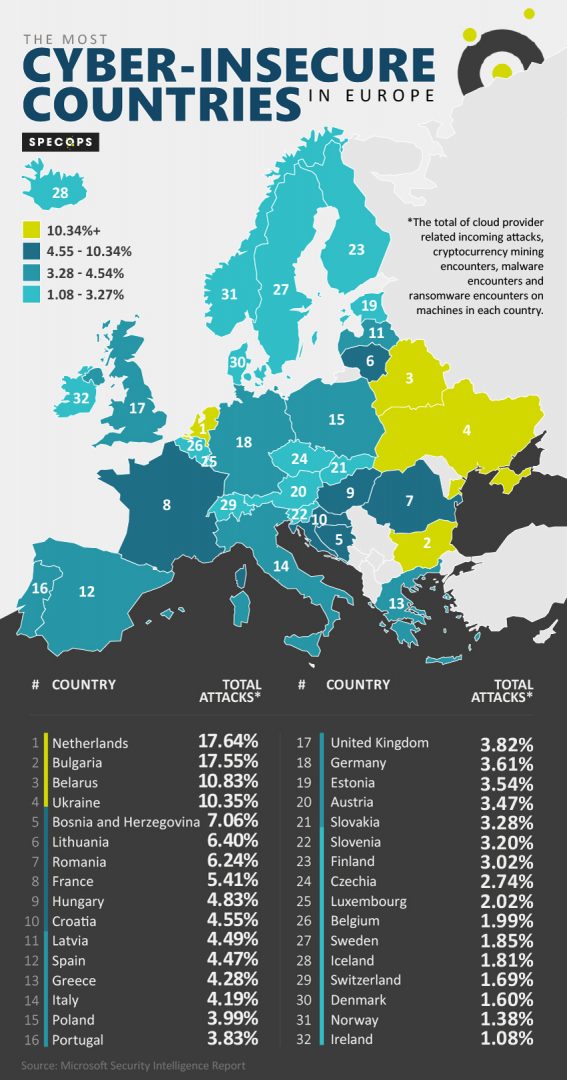business resources
Research: European Countries Most at Risk of Cyber Crime
8 Sept 2022, 4:08 am GMT+1
• Machines in the Netherlands are most likely to encounter cybercrimes; Ireland is least likely
• 10.17% of machines in Belarus encounter malware every month, making them the least cyber-secure country for malware encounters
• The UK and Ireland are among the countries least likely to encounter ransomware attacks and cryptocurrency mining (0.01% and 0.02%)
The severity of cyber-breaches has become more and more intense in recent years. As a result, security experts at Specops Software sought to find out which (Western) European countries are the most cyber-insecure for citizens.
To find out, Specops Software calculated which country is most likely to encounter cyber-crimes by analysing the percentage of cloud provider attacks on Azure and the monthly percentage of machines that encountered cryptocurrency mining, malware and ransomware.
Overall
The results show the Netherlands is the most vulnerable European country to cyber-crime, with the highest rate of cybercrime. This could be due to the large number of cloud provider incoming attacks (16.28%) to Microsoft Azure in their country.
Next is Bulgaria, who have experienced 17.55% incoming attacks/encounters. In third place is Belarus (10.83%), followed by Ukraine (10.35%) and Bosnia and Herzegovina (7.06%).
The United Kingdom rank 17th, due to a high number of cloud related attacks, in comparison to other European countries.
Ireland are ranked as the least vulnerable country in Europe, where they had the lowest cybercrime encounter rate in every category, except cloud provider attacks – where there is 0.36% recorded incoming attacks on Azure, detected by Azure’s Security Centre.
Cloud attack encounters
The Netherlands received the highest number of cloud provider incoming attacks, with data stating that 16.28% of Azure accounts have faced breaches. They are followed closely by Bulgaria (11.68%).
Other countries among the highest cloud attack encounters include France (2.73%), United Kingdom (2.02%) and Finland (1.72%).
 The most cyber-insecure countries in Europe. Source: Specops
The most cyber-insecure countries in Europe. Source: Specops
Cryptocurrency encounters
On average, Belarus has the highest number of cryptocurrency mining encounters every month, with 0.42% of machines recording the issue.
Next is Ukraine (0.33%), Bosnia and Herzegovina (0.25%) and Bulgaria (0.17%).
The least vulnerable country is Ireland, where only 0.01% of machines encountered cryptocurrency mining.
The United Kingdom, Norway, Denmark, Switzerland, Sweden, Finland, Austria, Germany and Netherlands are second least likely to encounter cryptocurrency mining, as only 0.02% of machines in each country had.
Malware encounters
Belarus has the most malware encounters in Europe, with 10.17% of machines in the country encountering them each month on average.
In second place is Ukraine (9.57%), followed by Bosnia (6.76%), Romania (5.92%) and Bulgaria (5.66%).
The country with the least malware encounters is Ireland, where only 0.7% of machines in the country encountered malware each month on average.
Finland (1.27%), Norway (1.33%), Netherlands (1.33%) and Denmark (1.35%) are among the countries least vulnerable to malware encounters.
Ransomware encounters
0.09% of machines in Ukraine encountered malware on average every month, making them the most insecure country to malware encounters in Europe.
Belarus are second most vulnerable, with 0.06% of machines encountering malware, followed by Bosnia (0.05%), Romania, Bulgaria, Hungary, Latvia, Greece and Croatia (0.04%).
Ireland, United Kingdom, France, Germany, Sweden, Switzerland, Denmark, Netherlands, Norway and Finland encountered the smallest number of ransomware threats, with only 0.01% of machines facing them each month.
With the risk of cyber-crime high in many European countries, Aimée Ravacon from Specops Software has suggested three distinct tips to reduce your risk of attacks:
“1. Stop re-using passwords. When you reuse your passwords, you are opening yourself up to cyber-crime since attackers use your login information from one site to target another site.
2. Use multi-factor authentication. Many online services now offer multi-factor authentication, but too few people are taking advantage of this extra security layer. This simple step just takes a minute but can protect you from falling victim.
3. Don’t click on strange links. Phishing emails are designed to look real and can even appear to come from people you know. But clicking on links in a phishing email can open a backdoor for an attacker.”
Share this
Contributor
Staff
The team of expert contributors at Businessabc brings together a diverse range of insights and knowledge from various industries, including 4IR technologies like Artificial Intelligence, Digital Twin, Spatial Computing, Smart Cities, and from various aspects of businesses like policy, governance, cybersecurity, and innovation. Committed to delivering high-quality content, our contributors provide in-depth analysis, thought leadership, and the latest trends to keep our readers informed and ahead of the curve. Whether it's business strategy, technology, or market trends, the Businessabc Contributor team is dedicated to offering valuable perspectives that empower professionals and entrepreneurs alike.
previous
Things You Need to Know if You’re Applying for a Job with a Record
next
What Can You Do about Sexual Harassment in the Workplace?